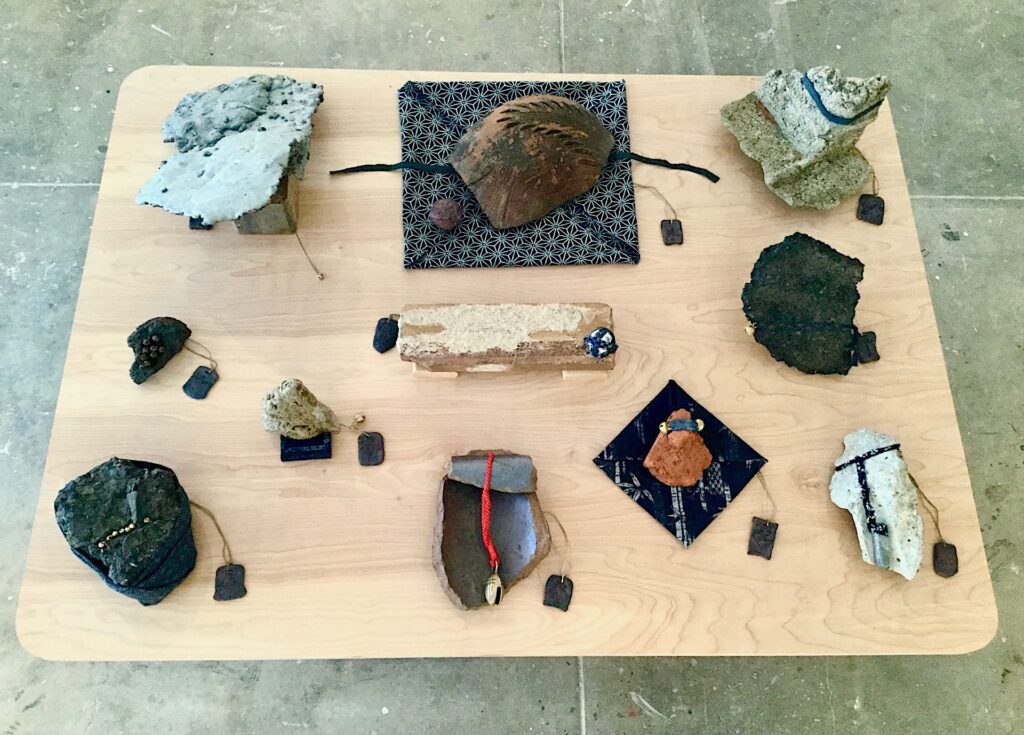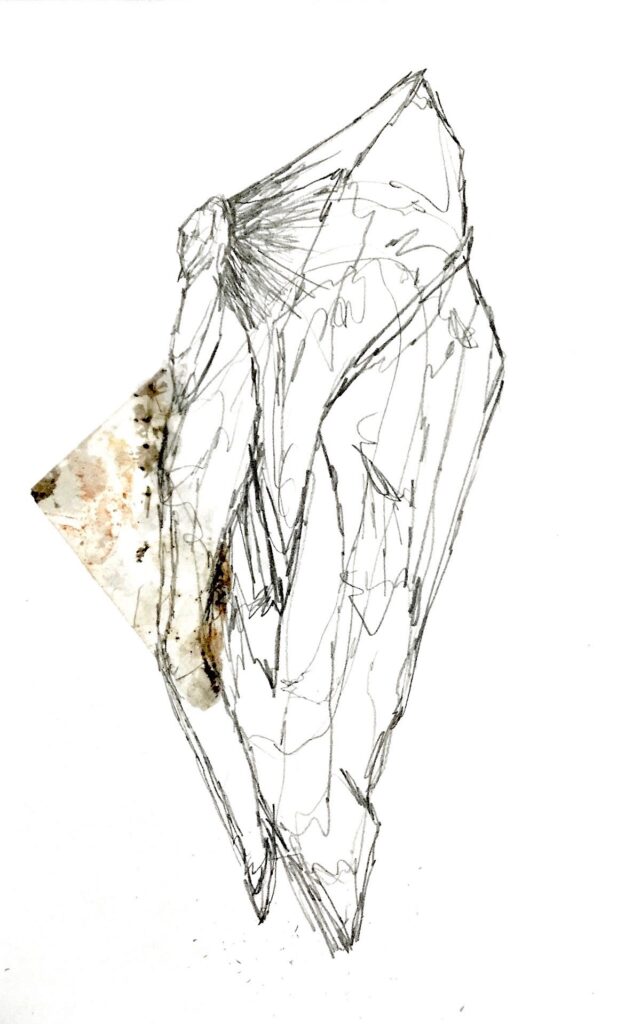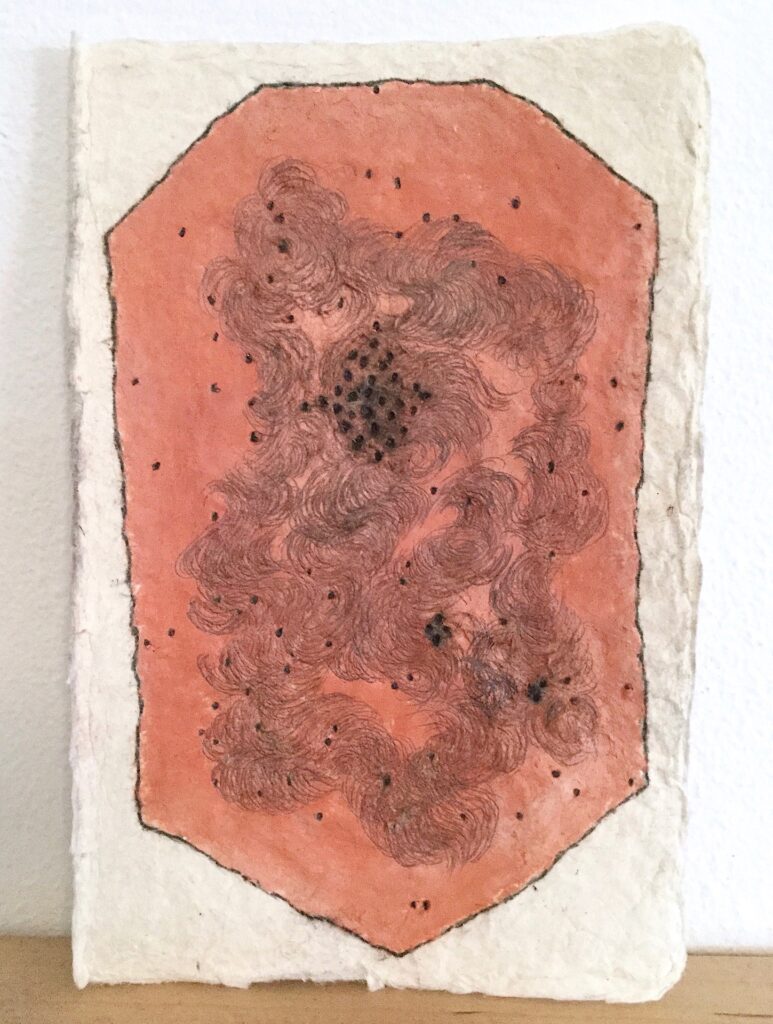Sara Osebold (b. 1975) is a contemporary, multi-media artist who creates drawings and sculptures and is based in Seattle. The artist’s work takes us on a sensory journey adding a dose of visual medicine. Mixed media drawings are fused together with ink, mica, graphite, clay, pigments, etc. creating visions of the unseen or the imaginative. Her sculptures bond fragments of the natural and modern worlds that fold up to take on another form entirely or stand guard to repel negative energies. Propelled by intuition and inspired by textures of the earth, Osebold’s quietly active transcendental works encourage us to embrace the unseen. We asked her about her art and inspirations to find out what fuels her work.

Backstory
Where were you born and raised?
I was born in Iowa City Iowa and then raised in Spokane, Washington from the age of four.
When did you begin to identify as an artist?
Around age five or so when my parents gave me pencils, chalk, and watercolors to play with and distract me from getting into trouble. I enjoyed the activity so much. When I would hear positive feedback, it only encouraged me to do more. It was never forced on me, just something I gravitated toward.

Was your family supportive of your decision to become an artist or are they supportive now?
Yes. They were my first encouragers. My Dad, out of concern, wished me to learn as much as I could about business. I tried to minor in it, but got about half-way through before dropping it. I did retain some basics though. They continue to be supportive, even if they may not always understand what I’m doing. They know it makes me engaged and keeps me thriving.
Did you attend art school?
Yes. I took summer art classes (drawing and ceramics) at the local Spokane art school as a kid. At Western Washington University, I took classes alongside my art history studies. It was inevitable this was the way for me to go and where my passion would never run out. I also completed a Bachelors of Fine Arts, Printmaking, at University of Washington and a Masters of Fine Arts, Sculpture, at Pratt Institute in Brooklyn, New York. I loved my art classes, my professors and the critiques amongst my peers. Some dear friendships were forged that I still keep to this day.

What are your biggest influences and who are some of your favorite artists?
Rocks, firstly. Then, moving the body by staying active and engaged with my surroundings. Keeping curious. Still being amused by the most mundane things. Walking with wonder and delight in the mystery of things. I get so much out of ancient art and practices. Art from ancient Sumer, Mesopotamia, Egypt, Persia… Indigenous art of various ethnic groups from North and South America and Japan: Inuit, Native American, Ainu, and Mesoamerica. Artists of Oceanic descent and artists of the Jomon Period as well. I can’t get enough of funerary items and cave paintings, their textures and mark making. Artists I admire are Joseph Beuys, Meret Oppenheim, Paul Klee and Alberto Giacometti.

Drawing
Sara’s drawings are hypnotic forms and both energetic and expressive. They echo elements of another world, artifacts of the unseen. Active and gestural linework, almost trancelike, create forms that seem to float and vibrate echoing a spirit in transit—coming and going from another realm. Mixing terracotta, asphalt oil, mica, pigments, rocks, ink and wax, many of these drawings feel like shamanic visions unfolding before our eyes, messages from beyond.
Tell us about your drawings… How do they relate to your sculptural works?
My drawings are my first love. They are of me and my immediate force. The markings are as individual as one’s signature. The line in drawing is the vitality. I want to use the line coming from my body and center to its fullest. The drawing connects to the sculpture in helping to bring this lightning of vitality to it. I figure out certain forms through the drawing practice that I then apply to the sculpture. I purposefully work back and forth between drawing and sculpture because they tend to influence each other.
How do you work with color?
I try not to meddle too much with the inherent quality of materials. I want the pigments, stone, clay, etc. to be allowed to show their essential potency with minimal manipulation on my part. I find the raw, terracotta clay to be enough as it imbues an irresistible warmth. Even when I add a veil of white gesso to a work on paper, the clay layer underneath glows through. I tend to stay with a limited palette, partly because of my intimidation at the thought of deciding amongst a whole range of colors, but mostly because I’ve gotten to a more pared down place, both in art and in general. Once I’ve found what works for clarity of form and potency of material, color becomes more essential, like a medicine, that I use very purposely and never randomly. The darker, blacker tones are directly linked with the feeling of security and protection-creating a place of safety.
Your drawings seem to possess a spiritual or healing energy. Do you consider your work to be spiritual?
I want the work to speak for itself to those who are experiencing it. I consider myself to be open to the spirit world and, no doubt, consciously and subconsciously am navigated by some kind of spiritual force(s) in my creative practice among other things. That being said, that aspect stays pretty close to me and not necessarily something I need to explain or make known in the work. What I do hope can be transferred to the viewer is a sense of warmth, healing and protection.

Sculpture
Sara’s sculptures are contemporary relics made from a diverse range of materials from urban and wild landscapes: cement fragments, asphalt rocks, wool felt, slate, seashells and stones. These sculptures are neoteric totems with primal souls. Talismanic time capsules made with collected ephemera of our time.
Where do you find your materials for the sculptures?
Since 2018, with the massive building boom in Seattle, I’ve seen a great deal of destruction and creation of new dwellings and high-rises. In response to that, taking note of all this defunct infrastructure left around construction sites has prompted me to collect(scavenge) these scraps of once sound building materials and use them as a basis for new sculptures. It’s been a good practice for me to take an existing industrial form and see what I can generate further from it.

Practice & Process
Tell us about your process… How do you begin a piece and does your process change depending on the materials?
My process is almost always intuitive when it comes to drawing. With sculpture, it may start off intuitively, but a plan develops soon after. I tend toward the conceptual. In this way, once I detect what is emerging forth, I hone in and then start to clarify, find my intent. From there, the process of honing and clarifying repeats until I feel it’s where it needs to be to be considered a complete work. However, there are projects where sketching ideas out and researching is necessary before I can begin making. I enjoy working both ways and feel each approach has great value; it brings constructive challenges and experiences. In general, I love to research. I love the history of art and culture.
Where do you work?
I make work in my home studio. The main bedroom has been converted into the art space. My husband, a writer and poet, also uses the studio where he has a desk for his daily practice. Thankfully, we are on the same page where our priorities are concerned. When it’s nice outside, I will use our side porch and I can get more messy with materials here (I achieve that pretty well indoors too) I work nearly every day…some days it’s graphite sketching, other days its more involved using table top and floor to work against.
What themes do you explore in your work?
I am deeply and endlessly fascinated by the underground/underwater-those things we can’t always see, but we know are teeming with life. The invisible makes us wonder, provides us mystery as well as sparks the imagination. The imaginative coupled with actual experience is a combination I love to explore. Also, the straddling of the natural and urban worlds (which many of us are a part of) interests me. How we are engaged with both and how they overlap in life. In this way, place itself is a constant in the work that emerges. How I fit in the place where I live, what I receive from it, what I can give back to it. I’m taken by the surreal aspects of life, what we feel makes sense and not always what is known to be true. Whatever the theme, my underlying essential is that the work has a warming principle and this warmth can be transferred directly to the viewer on a certain level.
How do you feel your work relates to contemporary art culture and how?
I think being present and engaged with place, my neighborhood and city, the arts community helps me to keep in touch with contemporary culture and creative activity. With this ongoing series based on infrastructure scraps, I’m working with current similar realities experienced in other cities around the globe. Now that Covid-19 has made its stark and grave mark on the world, it is another undeniable energy that is coming into the work, whether consciously or unconsciously, which, no doubt, many artists are navigating and being moved by right now.

What are you currently working on and what are you working towards? Do you have any upcoming exhibitions or projects?
I’m continuously oscillating between sculpture and works on paper. I started working on large scale, handmade paper which was gifted to me recently. I keep finding curious scraps of infrastructure laying around that I bring home to consider and wrestle with. I do try to finish a work each week, if possible. The time constraint sometimes aids in keeping ideas and the vision strong and ever clearer. The next known exhibition will be sometime in 2021. I’m collaborating with a musician and a poet in making succinct, singular works based on seven themes distinct to Seattle. It will be at 4Culture Gallery in Seattle.
Sara’s dedication and connection to the materials she uses transmits through her work. She is an artist who offers to share with us a powerful dose of deep, earth energy that strengthens our spirits and gives us hope for a better world. Grounding and protective, her work is just what we need to stay resilient during these treacherous times.
You can view and follow Sara’s work here:
Learn more about contemporary women artists:





